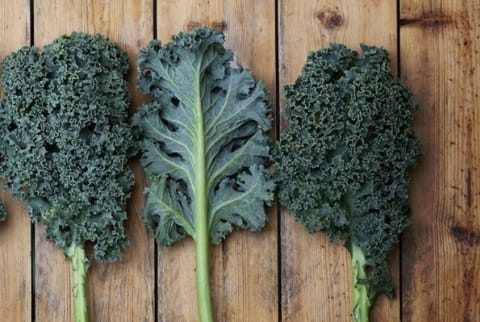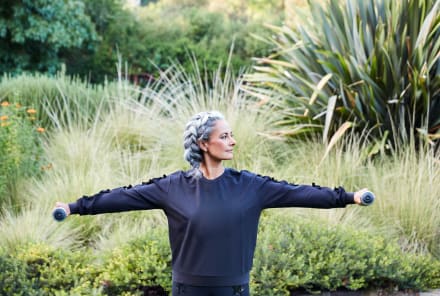Advertisement


The fastest way to turn your diet around? To go from not-so-great to almost perfect? The answer is organic leafy greens – those life-supporting, health-inducing, nutrient-packed edibles that should take up most of the space on your plate at every meal – not just at dinnertime.
Eat them or drink them, but just get them into your body every day – that’s my leafy green mantra, and I hope you'll make it yours.
Need a little more encouragement? Here’s the top-line low-down on my favorite health-promoters, the “leafys”:
Why Leafys?
It’s incredibly simple: they improve health, benefitting virtually every cell in your body! What’s so amazing about the leafys is that calorie for calorie, they deliver more nutrients than just about any other food on the planet. Loaded with fiber, vitamins, minerals, and phytochemicals, leafy greens give your body the artillery it needs to fight off potential killers like heart disease and cancer.
Meet The Leafys
My favorite leafy greens, from both a nutritional and taste standpoint, are kale, spinach, Swiss chard, mustard and dandelion greens. You can toss them into virtually anything, as long as you give them a good washing first! Eaten raw or cooked, my favorite leafys (as well as many others in the leafy green family) add just-right doses of vitamin A, C, K, folate, potassium and calcium to every meal.
Coddle Your Leafys
As most leafy greens come straight out of the soil, the majority, if not all your leafys, should be organic. If price is a concern, combine organic with conventionally grown leafys, to reduce costs as well as the toxic load. Once you’ve gotten your leafys home from the market, don’t let them sit around in the crisper too long or they’ll start to loose some of their nutrients. To minimize nutrient loss when cooking your leafys, be gentle and don’t overcook – do your steaming and sautéing as quickly as possible.
Leafys: Morning, Noon and Night
One way to boost your leafy green intake is to add them to your breakfast. Recently, during a stay on the West Coast, I was very pleasantly surprised by a room service veggie omelet that was stuffed with lightly steamed greens, and accompanied by a spinach side salad. It was a good reminder, even to a greens fanatic like me, that salad shouldn’t be limited to just lunch and dinner.
Sneak Them In, or Drink Them In
OK, so you’re not a huge salad eater? Not nuts for greens? Then try upping your intake by basically tricking yourself into eating leafys. Start by dropping a few fistfuls into soups and tomato sauce or tucking a pile of greens under fish, chicken or grass-fed meat.
You can also cut to the chase and just drink your greens by blending a few fist-fulls into your morning fruit smoothie. Short on time? Traveling without a blender? Then try my pre-measured powdered “greens-to-go” for the perfect caffeine-free, crash-proof way to start the day.
Go green!

For Dr. Frank Lipman, health is more than just the absence of disease: it is a total state of physical, mental, emotional, spiritual and social wellbeing. Dr. Lipman is a widely recognized trailblazer and leader in functional and integrative medicine, and he is a New York Times best-selling author of five books, How to Be Well, The New Health Rules, Young and Slim for Life, Revive and Total Renewal.
After his initial medical training in his native South Africa, Lipman spent 18 months working at clinics in the bush. He became familiar with the local traditional healers, called sangomas, which kindled his interest in non-Western healing modalities
In 1984, Lipman immigrated to the United States, where he became the chief medical resident at Lincoln Hospital in Bronx, NY. While there, he became fascinated by the hospital’s addiction clinic, which used acupuncture and Chinese medicine making him even more aware of the potential of implementing non-Western medicine to promote holistic wellbeing.
He began studying nutrition, acupuncture, Chinese medicine, herbal medicine, functional medicine, biofeedback, meditation, and yoga. Lipman founded the Eleven Eleven Wellness Center in 1992, where he combines the best of Western medicine and cutting edge nutritional science with age-old healing techniques from the East. As his patient, chef Seamus Mullen, told The New York Times, “If antibiotics are right, he’ll try it. If it’s an anti-inflammatory diet, he’ll do that. He’s looking at the body as a system rather than looking at isolated things.”
In addition to his practice, he is also an instructor in mbg's Functional Nutrition Program.
More from the author:
Functional Nutrition Training
Check out Functional Nutrition Coaching
A cutting-edge nutrition deep dive taught by 20+ top health & wellness experts
Learn moreMore from the author:
Functional Nutrition Training
Check out Functional Nutrition Coaching
A cutting-edge nutrition deep dive taught by 20+ top health & wellness experts
Learn more
For Dr. Frank Lipman, health is more than just the absence of disease: it is a total state of physical, mental, emotional, spiritual and social wellbeing. Dr. Lipman is a widely recognized trailblazer and leader in functional and integrative medicine, and he is a New York Times best-selling author of five books, How to Be Well, The New Health Rules, Young and Slim for Life, Revive and Total Renewal.
After his initial medical training in his native South Africa, Lipman spent 18 months working at clinics in the bush. He became familiar with the local traditional healers, called sangomas, which kindled his interest in non-Western healing modalities
In 1984, Lipman immigrated to the United States, where he became the chief medical resident at Lincoln Hospital in Bronx, NY. While there, he became fascinated by the hospital’s addiction clinic, which used acupuncture and Chinese medicine making him even more aware of the potential of implementing non-Western medicine to promote holistic wellbeing.
He began studying nutrition, acupuncture, Chinese medicine, herbal medicine, functional medicine, biofeedback, meditation, and yoga. Lipman founded the Eleven Eleven Wellness Center in 1992, where he combines the best of Western medicine and cutting edge nutritional science with age-old healing techniques from the East. As his patient, chef Seamus Mullen, told The New York Times, “If antibiotics are right, he’ll try it. If it’s an anti-inflammatory diet, he’ll do that. He’s looking at the body as a system rather than looking at isolated things.”
In addition to his practice, he is also an instructor in mbg's Functional Nutrition Program.
Watch Next
Enjoy some of our favorite clips from classes
Enjoy some of our favorite clips from classes
What Is Meditation?
Mindfulness/Spirituality | Light Watkins
Box Breathing
Mindfulness/Spirituality | Gwen Dittmar
What Breathwork Can Address
Mindfulness/Spirituality | Gwen Dittmar
The 8 Limbs of Yoga - What is Asana?
Yoga | Caley Alyssa
Two Standing Postures to Open Up Tight Hips
Yoga | Caley Alyssa
How Plants Can Optimize Athletic Performance
Nutrition | Rich Roll
What to Eat Before a Workout
Nutrition | Rich Roll
How Ayurveda Helps Us Navigate Modern Life
Nutrition | Sahara Rose
Messages About Love & Relationships
Love & Relationships | Esther Perel
Love Languages
Love & Relationships | Esther Perel











